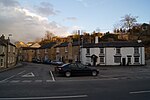Tadcaster Grammar School
1557 establishments in EnglandAcademies in North YorkshireAll pages needing cleanupEducational institutions established in the 1550sSecondary schools in North Yorkshire ... and 2 more
TadcasterUse British English from July 2021
Tadcaster Grammar School founded in 1557, is a coeducational secondary school and sixth form located near Tadcaster, North Yorkshire, England, educating children aged 11–18 years old, and has an on-site sixth form. The school is located in the hamlet of Toulston just outside the brewery town of Tadcaster. The school's catchment includes Tadcaster and its surrounding villages, while traditionally taking pupils from the York area, including villages such as Appleton Roebuck, Copmanthorpe, Bishopthorpe and Bilbrough.
Excerpt from the Wikipedia article Tadcaster Grammar School (License: CC BY-SA 3.0, Authors).Tadcaster Grammar School
Garnet Lane,
Geographical coordinates (GPS) Address Phone number Website External links Nearby Places Show on map
Geographical coordinates (GPS)
| Latitude | Longitude |
|---|---|
| N 53.87786 ° | E -1.30734 ° |
Address
Tadcaster Grammar School
Garnet Lane
LS24 9NB , Stutton with Hazlewood
England, United Kingdom
Open on Google Maps










